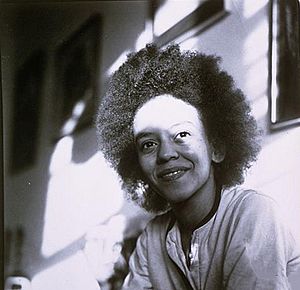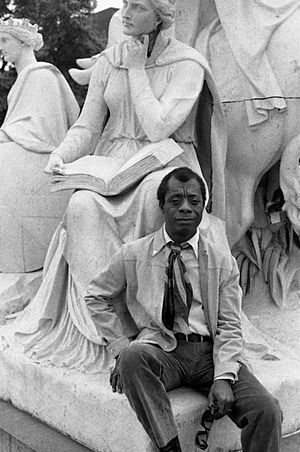Black Arts Movement facts for kids

Nikki Giovanni, a participant in the Black Arts Movement
|
|
| Years active | 1965–1975 (approx.) |
|---|---|
| Country | United States |
| Major figures | |
The Black Arts Movement (BAM) was an important arts and social movement led by African Americans in the 1960s and 1970s. Through art, poetry, music, and theater, the movement celebrated black pride and Black culture. It built on the achievements of earlier artists from the Harlem Renaissance.
The writer Larry Neal called the movement the "aesthetic and spiritual sister of Black Power." This means that BAM used art to express the same ideas of freedom and self-determination that the Black Power movement fought for. Artists looked to their African roots for inspiration. They wanted to show the true experience of being Black in America.
The poet and playwright Amiri Baraka is known as the founder of BAM. In 1965, he started the Black Arts Repertory Theatre School in Harlem, New York. His work inspired others to create similar arts organizations all over the United States. While some of these groups only lasted for a few years, their impact has been long-lasting.
Contents
Background of the Movement

African Americans have always made amazing contributions to American art and culture. However, for a long time, these contributions were not recognized because of racism. Despite this, Black artists continued to create powerful work that reflected their lives.
A major period for Black artists was the Harlem Renaissance in the 1920s. This was a time when Black literature, music, and art blossomed in Harlem, New York. The Black Arts Movement is sometimes called the "Second Renaissance" because it was another great explosion of Black creativity.
During the Civil Rights Movement of the 1950s and 1960s, activists realized that art could be a powerful tool for change. Writers like James Baldwin showed that a new "Black aesthetic," or style of art, was possible. Art groups like the Umbra Poets were formed, setting the stage for the Black Arts Movement.
The Movement Begins
The Black Arts Movement is often said to have started in 1965. This was the year Amiri Baraka opened his theater school in Harlem after the assassination of Malcolm X. Artists in the movement wanted to create art that was politically active and explored the African American experience. They rejected old ideas and wanted to build something new.
BAM artists believed in "self-determination," which means Black people should have control over their own communities, businesses, and art. This led to the creation of many Black-owned theaters, publishing companies, and magazines.
While New York City was a major center for the movement, BAM was happening all across the country. It started as many local groups that eventually connected to form a national movement. Magazines and journals like Freedomways and Black Dialogue helped spread the ideas of BAM and connected artists from different cities.
The Wall of Respect
In 1967, a group of artists in Chicago painted a large mural called the Wall of Respect. The mural celebrated over 50 Black heroes, including Martin Luther King Jr., Malcolm X, and famous artists like Aretha Franklin.
The Wall of Respect became a famous symbol of the movement. It was a beautiful piece of public art that showed Black pride and creativity. It inspired communities across the country, and soon, thousands of similar murals were painted in Black neighborhoods. The mural was so respected that even rival street gangs agreed to be peaceful near it.
The National Black Theatre
In 1968, the actress and director Barbara Ann Teer founded the National Black Theatre in Harlem. Teer was a key female leader in the Black Arts Movement. Her theater was one of the first Black theaters to support itself financially.
The plays at the National Black Theatre were different from traditional theater. They often blurred the line between the actors and the audience, encouraging everyone to get involved. The goal was to use theater to inspire social change.
The Black Aesthetic
"The Black Aesthetic" was a core idea of the Black Arts Movement. It was a set of beliefs about what Black art should be. While different people had slightly different ideas, they all agreed on a few main points.
First, art should be connected to the lives of Black people. Second, it should celebrate Black culture and history. Third, it should be a tool for social change. The writer Larry Neal said the goal was to challenge "white ways of looking at the world."
The activist Maulana Karenga said Black art should be:
- Functional: It should have a purpose, not just be "art for art's sake."
- Collective: It should be for the entire community, not just one person.
- Committed: It should support the struggle for freedom and justice.
This new way of thinking encouraged Black artists to be proud of their identity and create art for their own communities.
Important Works of the Movement
"Black Art" by Amiri Baraka
Amiri Baraka's poem "Black Art" is one of the most famous works of the movement. In the poem, Baraka argues that poems should be active and powerful. He criticized art that he felt did not represent the struggle for Black freedom.
The poem's aggressive and energetic style has been compared to early hip-hop music. Baraka wanted art that was "live" and unapologetic. He believed that Black artists needed to create their own world, free from outside influences, to truly express themselves.
"The Revolutionary Theatre" by Amiri Baraka
In his 1965 essay "The Revolutionary Theatre," Baraka explained his vision for a new kind of theater. He said that this theater should be a force for change in the world. It should shock audiences and make them think about the world as it is, and as it should be.
Baraka argued that Black artists should turn away from the "white aesthetic" and create something that reflected their own identity. He wrote, "The Revolutionary Theatre is shaped by the world, and moves to reshape the world." His essay was a call to action for artists to use their work to fight for a better future.
Lasting Impact and Legacy

The Black Arts Movement lasted for about ten years, but its influence is still felt today. It was one of the most important periods in African-American literature and art.
The movement inspired Black people to create their own publishing houses, magazines, and art institutions. It also led to the creation of Black Studies programs in universities, where students could learn about Black history and culture.
BAM opened doors for many new voices in American literature. Writers like Toni Morrison, Alice Walker, and August Wilson were influenced by the movement's ideas. The writer Ishmael Reed said that BAM showed minority artists that "you don't have to assimilate. You could do your own thing, get into your own background, your own history, your own tradition and your own culture."
The Black Arts Movement gave a powerful voice to African Americans and helped change the face of American culture forever.
See also
- African-American art
- African American culture
- Africanfuturism
- Afrofuturism
- Black pride
- Négritude
- Progressive soul

